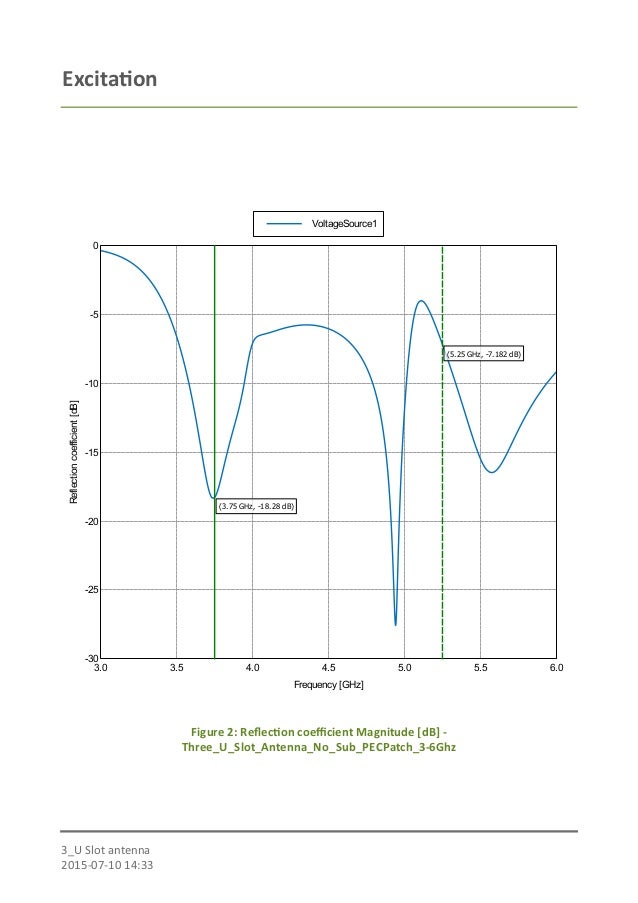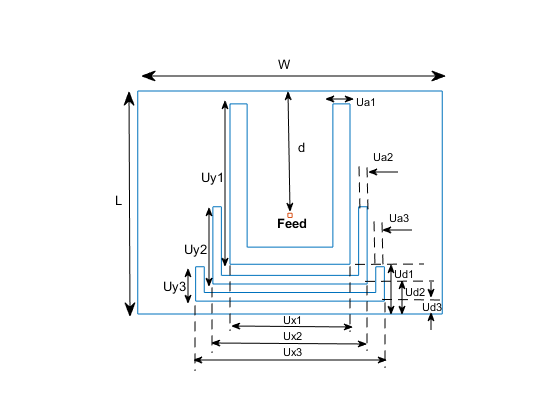U Slot Antenna
- Slot antennas are usually used at UHF and microwave frequencies at which wavelengths are small enough that the plate and slot are conveniently small. At these frequencies, the radio waves are often conducted by a waveguide, and the antenna consists of slots in the waveguide; this is called a slotted waveguide antenna.
- Been reported, such as U-slot MSA 5 and E-shaped patch antenna 6. In addition, narrow bandwidth can be expanded by increasing the substrate thickness, whereas it will launch stronger surface waves. As a result, the radiation efficiency and patterns of the antenna will be further degraded.
- The slot antenna, consisting of a narrow slit in a ground plane, is a very versatile antenna. With modification, it is amenable to waveguide, coplanar waveguide (CPW), coaxial, slot line, or microstrip feeding schemes and has been used in all aspects of wireless and radar applications.

A slot antenna consists of a metal surface, usually a flat plate, with one or more holes or slots cut out. When the plate is driven as an antenna by an applied radio frequency current, the slot radiates electromagnetic waves in a way similar to a dipole antenna. The shape and size of the slot, as well as the driving frequency, determine the radiation pattern. Slot antennas are usually used at UHF and microwave frequencies at which wavelengths are small enough that the plate and slot are conveniently small. At these frequencies, the radio waves are often conducted by a waveguide, and the antenna consists of slots in the waveguide; this is called a slotted waveguide antenna. Multiple slots act as a directivearray antenna and can emit a narrow fan-shaped beam of microwaves. They are used in standard laboratory microwave sources used for research, UHF television transmitting antennas, antennas on missiles and aircraft, sector antennas for cellular base stations, and particularly marine radar antennas. A slot antenna's main advantages are its size, design simplicity, and convenient adaptation to mass production using either waveguide or PC board technology.
Structure[edit]
U- SLOTS ANTENNA DESIGN Four band linear polarization asymmetrical U slot patch antenna’s geometry is shown in figure 1.In ground plane under the patch, a square copper plate was used along its edge having length L=50 mm. Air is used as substrate and coaxial probe is connected directly to the patch. Inner and outer. U-slot Patch antenna has been reported recently for 5 GHz WLAN 7, and also a monopole antenna for WiMAX applications was proposed in 8. In this paper, a double U-slot microstrip patch antenna is designed and simulated for WiMAX bands.
As shown by H. G. Booker in 1946, from Babinet's principle in optics a slot in a metal plate or waveguide has the same radiation pattern as a driven rod antenna whose rod is the same shape as the slot, with the exception that the electric field and magnetic field directions are interchanged; the antenna is a magnetic dipole instead of an electric dipole; the magnetic field is parallel to the long axis of the slot and the electric field is perpendicular. Thus the radiation pattern of a slot can be calculated by the same well-known equations used for rod element antennas like the dipole. The waves are linearly polarized perpendicular to the slot axis. Slots up to a wavelength long have a single main lobe with maximum radiation perpendicular to the surface.
Antennas consisting of multiple parallel slots in a waveguide are widely used array antennas. They have a radiation pattern similar to a corresponding linear array of dipole antennas, with the exception that the slot can only radiate into the space on one side of the waveguide surface, 180° of the surrounding space. There are two widely used types:
- Longitudinal slotted waveguide antenna - The slots' axis is parallel to the axis of the waveguide. This has a radiation pattern similar to a collinear dipole antenna, and is usually mounted vertically. The radiation pattern is almost omnidirectional in the horizontal plane perpendicular to the antenna over the 180° azimuth in front of the slot, but narrow in the vertical plane, with the vertical gain increasing approximately 3 dB with each doubling of the number of slots. The radiation is horizontally polarized. It is used for vertical omnidirectional transmitting antennas for UHF television stations. For broadcasting, a cylindrical or semicircular waveguide is sometimes used with several columns of slots cut in different sides to give an omnidirectional 360° radiation pattern.
- Transverse slotted waveguide antenna - The slots are almost perpendicular to the axis of the waveguide but skewed at a small angle, with alternate slots skewed at opposite angles. This radiates a dipole pattern in the plane perpendicular to the antenna, and a very sharp beam in the plane of the antenna. Its largest use is for microwave marine radar antennas. The antenna is mounted horizontally on a mechanical drive that rotates the antenna about a vertical axis, scanning the antenna's vertical fan-shaped beam 360° around the water surface surrounding the ship out to the horizon with each revolution. The wide vertical spread of the beam ensures that even in bad weather when the ship and the antenna axis is being rocked over a wide angle by waves the radar beam will not miss the surface.
History[edit]

The slot antenna was invented in 1938 by Alan Blumlein, while working for EMI. He invented it in order to produce a practical type of antenna for VHF television broadcasting that would have horizontal polarization, an omnidirectional horizontal radiation pattern and a narrow vertical radiation pattern.[1][2]
Prior to its use in surface search radar, such systems used a parabolic segment reflector, or 'cheese antenna'. The slotted waveguide antenna was the result of collaborative radar research carried on by McGill University and the National Research Council of Canada during World War II.[3] The co-inventors, W.H. Watson and E.W. Guptill of McGill, were granted a United States patent for the device, described as a 'directive antenna for microwaves', in 1951.[4]
Other uses[edit]
In a related application, so-called leaky waveguides are also used in the determination of railcar positions in certain rapid transit applications. They are used primarily to determine the precise position of the train when it is being brought to a halt at a station, so that the doorway positions will align correctly with queuing points on the platform or with a second set of safety doors should such be provided.
See also[edit]
- Microwave Radiometer (Juno) (has a slot array antenna)
- RIMFAX (radar for Mars rover has slot antenna design)
References[edit]
- ^Blumlein, Alan (1938-03-07), 'Improvements in or relating to high frequency electrical conductors or radiators', British patent no. 515684
- ^Burns, Russell (2000). The life and times of A.D. Blumlein. Institution of Engineering and Technology. ISBN0-85296-773-X.
- ^Covington, Arthur E. (1991). 'Some recollections of the radio and electrical engineering division of the National Research Council of Canada, 1946-1977'. Scientia Canadensis: Canadian Journal of the HIstory of Science, Technology and Medicine. 15 (2): 155–175. doi:10.7202/800334ar.
- ^Watson, William Heriot; Guptill, Ernest Wilmot (6 November 1951), Directive Antenna for Microwaves, retrieved 20 December 2016
External links[edit]
- 'Slot Antennas'. Antenna Theory.
- Slotted Waveguide Antennas Antenna-Theory.com
- Antenna Theory Tutorial
- Antenna Basic Terms
- Types of Antennas
- Antenna Arrays
- Wave Propagation
- Antenna Theory Useful Resources
- Selected Reading
Slot Antenna is an example of Aperture antenna. A rectangular slot is made on the conducting sheet. These slot antennas can be formed by simply making a cut on the surface, where they are mounted on.
Frequency Range
The frequency range used for the application of Slot antenna is 300 MHz to 30 GHz. It works in UHF and SHF frequency ranges.
Construction & Working of Slot Antennas
The use of slot antennas is well understood through its working principle. Let us have a look at the structure of a slot antenna.

When an infinite conducting sheet is made a rectangular cut and the fields are excited in the aperture (which is called as a slot), it is termed as Slot antenna. This can be understood by observing the image of a slot antenna. The following image shows the model of a Slot antenna.
The working of Slot Antenna can be easily understood through Babinet’s principle of optics. This concept gives an introduction to the slot antennas.
Babinet’s Principle
Babinet’s principle states that- “When the field behind a screen with an opening is added to the field of a complementary structure, the sum is equal to the field when there is no screen”.
The above images clearly explain the principle. In all the regions, which are non-collinear with the beam, the above two screens, in figures 1 & 2, produce the same diffraction pattern.
Case 1 − Consider a light source and a conducting plane (field) with an aperture before a screen. The light does not pass through the opaque area, but passes through the aperture.
Case 2 − Consider the light source and a conducting plane of the size of the aperture in the previous case, being held against the screen. The light does not pass through the plane but through the remaining portion.
Case 3 − Combine these two conducting planes of both the cases and put before the light source. The screen is not placed to observe the resultant combination. The effect of screen gets nullified.
Working of Slot Antenna
This principle of optics is applied to electromagnetic waves for the wave to get radiated. It is true that when a HF field exists across a narrow slot in a conducting plane, the energy is radiated.
The image shows a slot antenna, which explains well about its working.
Consider an infinite plane conducting screen is taken and pierced with apertures of desired shape and size and this will be the screen of slot antenna. Another screen is considered interchanging the places of aperture and screen area which is the complementary screen.
These two screens are said to be complementary as they result in complete infinte metal screen. Now, this becomes the slot antenna. The terminal impedance is quite desirable for the radiation.

Radiation Pattern
U Slot Antenna Signal
The radiation pattern of the Slot antenna is Omni-directional, just like a half-wave dipole antenna. Take a look at the following illustration. It shows the radiation pattern of Slot antenna drawn in Horizontal and Vertical planes respectively
Linearly Polarized Hmsiw U-slot Antenna
Advantages
The following are the advantages of Slot antenna −
- It can be fabricated and concealed within metallic objects
- It can provide covert communications with a small transmitter
Disadvantages
The following are the disadvantages of Slot antenna −
- Higher cross-polarization levels
- Lower radiation efficiency
U Slot Antenna Hfss
Applications
U Slot Patch Antenna Bandwidth
The following are the applications of Slot antenna −
U Slot Antenna
- Usually for radar navigational purposes
- Used as an array fed by a wave guide